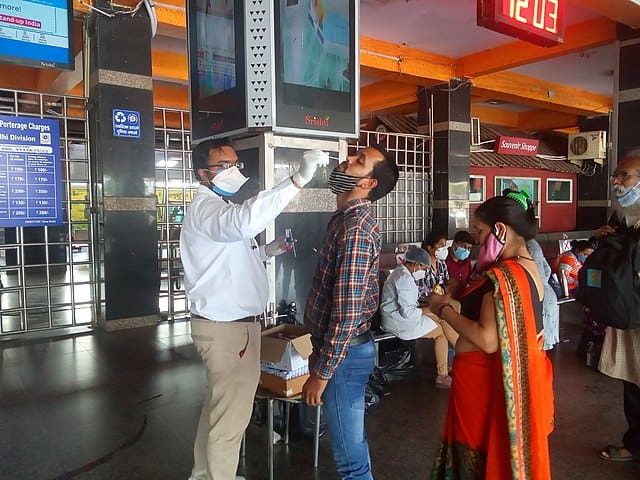On June 22, 91 out of the 1,648 new cases of COVID in Mumbai were hospitalised, taking the total number of occupied beds to 666. The city makes up for more than half of the daily reported cases in the state as Maharashtra had 3,260 patients on the same day.
Even as cases in Mumbai have dropped since June 15th, when the daily load shot up to 2,348, and active patients have dropped from 14,146 on June 21st to 13,501 on June 22nd, the number of people occupying hospital beds has increased. Currently, there are 24,765 beds reserved for COVID patients. The latest data from the Brihanmumbai Municipal Corporation (BMC) shows that of the total hospitalised, 85 are currently on oxygen support. There have been 22 deaths in Mumbai this month, most of whom were senior citizens with comorbidities.
The cases have been on the rise since the last week of May. However, on June 1st, for the first time since March, a little over a hundred people had occupied hospital beds across the city – 739 new cases were reported that day, of which 29 were hospitalised. The daily number went on to increase in the first week of the month, reaching 1,242 cases on June 7th.
“There is nothing to worry about because the testing has increased. Whatever the cases we are getting are very mild to moderate and hospitalisation against the total number of positive cases is very less, not more than 4 to 5 per cent,” said Dr Balkrishna Adsul, dean of the Seven Hills Hospital, a dedicated COVID government facility.
Read more: Mumbaikars speak up about the city’s healthcare budget
More testing, more numbers
There has also been a rise in the test positivity rate (TPR), which determines the percentage of people who test positive for the virus out of the overall who have been tested. From 8.4 per cent on June 1st to 13.3 per cent on June 15th, the TPR in Mumbai stands at 20.2 per cent as of June 22nd.
“You see a rise in TPR because there has been selective testing of high-risk contacts. When you test more people who show symptoms, they are bound to be positive,” Dr Adsul explained. As of June 21st, 11,155 contacts were traced within 24 hours, out of which 8,836 were identified as high-risk contacts while 2,319 were identified as low-risk contacts.
According to reports, genome sequencing on more than 800 samples from Mumbai and Pune, between April and mid-June showed the prevalence of Omicron sub-variants BA.2 and BA.2.38. A telephonic study on 116 patients infected with BA.2.38 showed that the majority of those infected with BA.2 and BA.2.38 suffered mild illness and did not require hospitalisation.
“These variants are certainly mild but it is important to remember that the pandemic is still on and people should take precautions and follow COVID appropriate behaviour whether they have testing positive or not,” Dr Adsul said.
Earlier this month, BMC commissioner Iqbal Singh Chahal had warned that with the arrival of the monsoon, there is a likelihood of more symptomatic cases of COVID-19. Ordering his staff to increase testing, he had said, “Better to plan for the worst and hope for the best.”

Another year of COVID in Mumbai?
The rise in COVID cases this month is not a cause of concern for the 42-year-old Sanjay Soni, who works as a sweeper at the Santacruz railway station and lives in the nearby slum. “Both me and my wife are vaccinated,” he said. He added that they have managed to keep COVID out of their house ever since the pandemic began.
“We never tested positive. She (his wife) works as a housekeeping staff at a hospital. We both got vaccinated when COVID in Mumbai started, now I am waiting for my third dose,” Soni said. The father of two asked this reporter to notify him when the third dose is rolled out at government facilities.
When asked if the cases are going to reduce anytime soon, Dr Adsul said, “It is difficult to predict but we may see a rise as rains intensify in July because more people suffer through cough and cold during these days, which may lead to a rise in testing and show us a rise in positive cases.”
Chahal had also asked the health department to keep jumbo centres adequately staffed and on alert in case hospitalisation rises. He had instructed additional municipal commissioners to visit jumbo centres in their jurisdictions and ensure they are ready for the monsoon. They were asked to check if the facilities need dewatering pumps, structural stability certification, fire safety mechanism, housekeeping, catering, paramedical and medical staff and oxygen manufacturing plants.
Multiple attempts were made to reach BMC officials for a confirmation on the matter but there were no responses. The dean of BMC’s BKC Jumbo COVID Centre, Dr Rajesh Dere, said, “Only this jumbo centre is admitting patients at the moment. We are seeing 10 to 15 patients admitted daily. There is a variation in the age group, we are seeing mostly above 18 years to 45 to 50-year-olds.”
He added that the jumbo centre under him has four dewatering pumps and has cleared up all the gutters. Dr Dere said that there is nothing to worry about in terms of severity of infection or excess hospitalisation right now, “but we have to be cautious and cannot be complacent.”